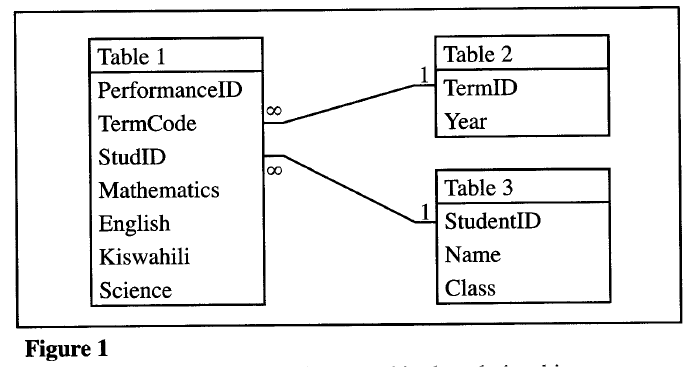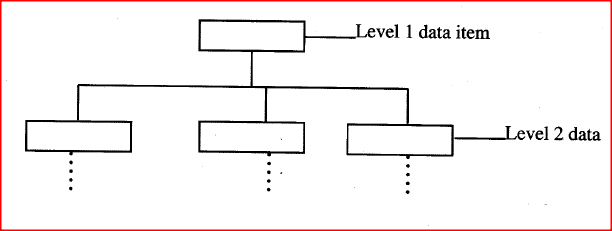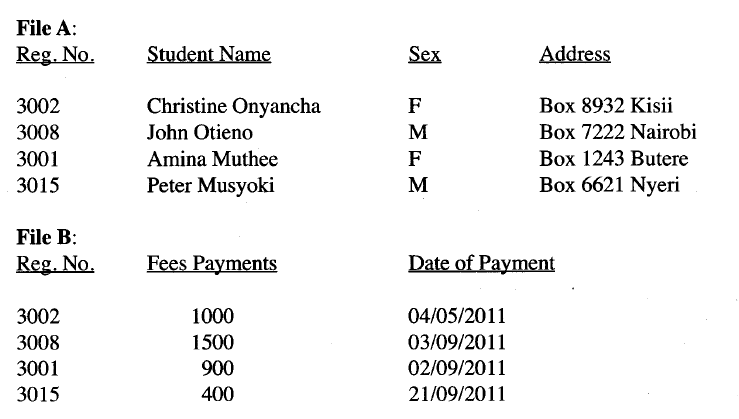|
Difference between a primary key and a a foreign key while designing a database
0 Comments
State three responsibility of a Database administrator in an organization.
With an aid of a diagram, explain one-to-one database relationship. A one-to-one relationship is created if and only if the relating field in both tables are primary keys
(a) List three ways by which you can provide a common link or relationship between the tables in a database software. (3mks)
(b) What is referential integrity (1mk)
With the aid of a diagram, describe the Hierarchical Database Model.
Data items are arranged in a tree like format.
Factors
(c) (i) Name three types of validation checks during data entry in data processing.
State three reasons why it is important to define datatypes of fields in a database correctly.8/1/2021 State three reasons why it is important to define datatypes of fields in a database correctly.
Reasons for defining datatypes in databases
Figure 1 shows relationships between tables in a database.
Identify two primary and two foreign keys used in the relationship.
Primary keys
A) State three hardware devices that may be required to connect a computer to an existing local area network. (3 marks)
B) A publisher intends to use a desktop publishing programme to create a publication which is to have many graphics. State three ways in which the graphics may be acquired for this purpose. (3 marks)
C) Interpret each of the following spreadsheet formula:(i) = countif(D2:D9, “>“&B4) (2 marks) (ii) sumif(B3 :B 11, “4M”, D3 :D11) (2 marks) (i) = Countif (D2 : D9, “>“ & B4)
(D) The following are the fields of products table in a database created to store records of products manufactured in a factory:
II. State three properties to be put in place during table design to ensure integrity of the data entered. (3 marks) I) Product Number — Number/Autonumber/Text
A school keeps student records in a database. The data is coded before entry.State three reasons why the coding is necessary.
With the aid of a diagram, describe the Hierarchical Database Model.
(b) List three factors that should be considered when developing a database application and give reasons why each should be considered.
(c) (i) Name three types of validation checks during data entry. (ii) Differentiate between primary key and index key RESPONSES
Data items are arranged in a tree like format.
Access is through a single path and all from one single item called the root component. (b) Factors .
What is an information system?
(a) (i) What is an information system?
(ii) State two roles of an information system. (b) Describe the following file organisation methods: (i) random file organisation; (ii) sequential file organisation. (c)The following records were extracted from two files that contained student data.
(i) Which of the two files above represents a Transaction file?
(ii) Give a reason for your answer in c(i) above. (iii) Name the other type of file represented above. (d)An airline uses an information system whereby if a passenger at station A books a plane seat,this transaction is immediately shown at stations A and B such that no other passenger can book the same seat. (i) Identify this data processing mode. (ii) State two advantages and two disadvantages of this data processing mode. RESPONSES
(a)(i) Information system is an arrangement of people, data, processes, communication and IT that interact to support problem solving.
(ii) Improve day-to-day operation
(ii) Method of storing or retrieving information that requires the program to start reading at the beginning and continue until it finds the desired data. (c) (i) File B. (ii) Transaction file: It contains data which is regularly added. Has data/fee payment . (iii) Master File: It contains records that do not change regularly like in file A.
(d) (i) Real time processing.
(ii) Advantages
Describe the following types of relationships as used in Database design:One-to-one and One-to-many.(a) One-to-one;
(b) One-to-many.
(a) State four activities of the planning stage of systems development. (4 marks)
Activities at the planning stages
State the purpose of each of the following in database design.(a) input mask
(b) default value
Using two examples, explain the term field properties as used in database design.
(b) Below is an extract from a hospital database table.
(i) State with reasons the most suitable data types for the following fields:
(iii) What is the purpose of a primary key field in database design? (iv) Describe how information about patients who registered after 09/08/06 can be extracted from the database.
(a)Field property:
Distinguish between Real, Integer and Character data types as used in programming ( 3mks)
Related SearchesName two types of relationships that can be applied in database design (2mks)
State three operations that can be performed on relational database files
The information below is maintained by the patron of wildlife club in a school. Study it and answer the questions that follow.
(a) Describe the field values, records and file.
(b) State the most appropriate primary key for the list. (c) State the most appropriate data type for the fields: (i) admission number; (ii) membership number. (d) If a database was to be created for the list; Forms, Tables, Queries and Reports are likely to be used. (i) State the purpose of each of these objects. (ii) Which objects cannot be used to store the data in the list? (e) (i) How many field values are in the list? (ii) How many records are in the list?
EXPECTED RESPONSES
(a)The field values are the values assigned to the attributes, that is, actual names, classes.
(c) (i) Text/Number/character. (ii) Text/Character/String/alphanumeric. (i)
(ii) 11 Distinguish between the following pairs of terms
(i) Data verification and data validation
Data Validation
Name two features of database package
A head teacher keeps the following student details in a database: Name,address, Town, Date of Birth, Marks scored, Fees paid.
i) Name the most appropriate primary key. Give a reason
ii) For each item in the student’s details above, indicate its most appropriate data type as used in the database. iii) Explain why input screens are better data entry designs than entering data directly to a table. b) List two career opportunities associated with databases. c) Distinguish between: i) A table in word-processing application and a table in a database application ii) Mouse pointer and insertion point. d) Outline the steps to be followed in order to merge cells in a word processing table.
RESPONSES
i)Name the most appropriate primary key. Give a reason. Name alone is not unique though it is very rare that two or more students will share the same name. ii)For each item in the student's details above, indicate its most appropriate data type as used in the database.
Differentiate between the following pair of terms as used in database design:Input mask and design and Table and query
a)Input mask and design
An input mask often refers to a string expression that a developer defines which governs what is allowed to be entered into a typical edit/input box. b) Table and query Table - the basic unit of storing data in database Query - a view created from table(s) that returns specific records based on a criterion. Distinguish between the following sets of terms as used in spreadsheets. Worksheet and workbook, Filtering and sorting
b) A student’ database comprises of students’ details table and fees received table as shown below:
Students’ details table
i) State the primary key field for each table.
ii) State the field, which should serve as the linking field for the two tables. c) Describe the following terms with respect to computer security: i) Logic bombs ii) Physical security iii) Tapping d) List three functions of antivirus software.
(i) Log files
(i)State the primary key field for each table.
c) Describe the following terms with respect to computer security: i)Logic bombs A computer virus that is activated after a series of event/commands/date ii) Physical security Threats that threaten the physical nature of computer equipment e.g. Fire, Lightening water, building access etc iii) Tapping.
|
Categories
All
Archives
December 2024
|
Can't find what you are looking for? Don't worry, Use the Search Box Below.
|
Primary Resources
College Resources
|
Secondary Resources
|
Contact Us
Manyam Franchise
P.O Box 1189 - 40200 Kisii Tel: 0728 450 424 Tel: 0738 619 279 E-mail - sales@manyamfranchise.com |






















 RSS Feed
RSS Feed

